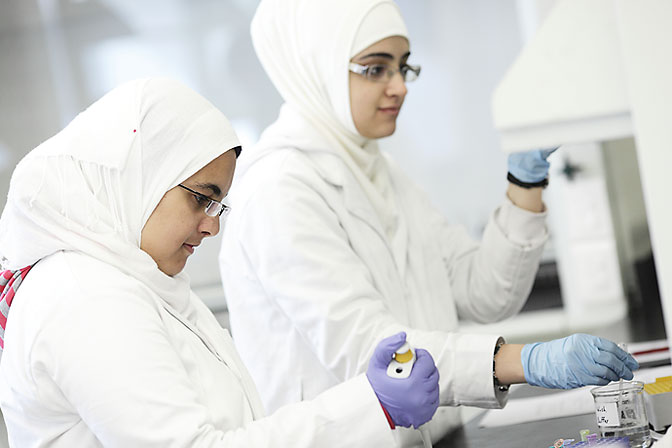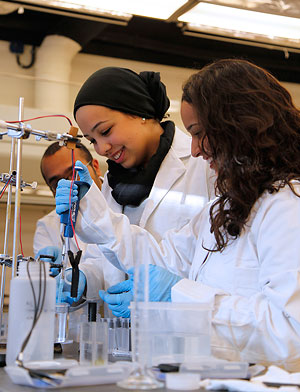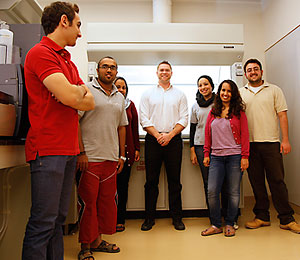

Biological Oasis
New Biological Sciences Program at CMU-Qatar Provides Much Needed Science Education
by Jocelyn Duffy

CMU-Q biological sciences students Ridin Balakrishnan, Mei Elgindi, and Hiba Al-Ashtal (from left to right) work in the lab.

Samer Younes, Ridin Balakrishnan, Hadya Elshakh, Ken Hovis, Mei Elgindi, Hiba Al-Ashtal, Raji Katibe (from left to right).
Top: High school students pipette buffer into their well plates as part of the Biotechnology Explorer Program at CMU-Q.
All photos courtesy of MPR at CMU-Q
Qatar, like most countries in the Middle East, has long been known for one thing—fossil fuels like oil and natural gas. But the Qatari government has turned its focus to another valuable resource— its people. Qatar and its Qatar Foundation are investing in the country’s future by dedicating vast amounts of capital to education and research, and Carnegie Mellon is playing a part.
The goal of the Qatari plan is to transform the country into a knowledge-based society by 2030. In the late 1990s, the Qatar Foundation built what is known as Education City, a sprawling campus on the outskirts of the Qatari capital of Doha where six U.S. universities now have branches, including Carnegie Mellon.
Another component of the plan is to ramp up the country’s health care and biotechnology sectors. The Qatar Foundation has opened a number of biomedical research institutes, including the Qatar Biomedical Research Institute and Sidra Medical and Research Center. Until recently, none of the Education City universities had biology programs in place to train future scientists. Last year, Carnegie Mellon decided to fill that gap, launching 4-year bachelor’s degree programs in biological sciences and computational biology.
“This is an important way to prepare future leaders in science who will be able to fill positions in these new world-class research institutions,” said Ken Hovis (S’11), assistant teaching professor of biological sciences at CMU-Qatar (CMU-Q).
Students can enter the program either by transferring from the premedical program at Weill Cornell Medical College in Qatar (WCMC-Q), or enrolling in CMU-Q as first-year students. All students receive their degrees from Carnegie Mellon. The first group of six transfer students began classes in the Fall 2011 semester after completing the WCMC-Q premed program. They all had decided that they either no longer wanted to attend medical school, or wanted to pursue other areas of science before applying to medical school.
“I wanted to explore more, do more research, see other possibilities,” said senior Ridin Balakrishnan, who is part of the first class of transfer students.
The CMU-Q biological sciences students engage in the same research-focused coursework as the biological sciences students at CMU in Pittsburgh. The Qatar students also have the opportunity to travel to and work in labs at the Pittsburgh campus during the summer.
“The research opportunities at CMU have been great,” said senior Mei Elgindi of her summer on the Pittsburgh campus. “When we go back we plan to continue doing research with our professors in Qatar.”
This hands-on research experience is different from what many students from Qatar and neighboring countries in the Gulf region may have encountered in their high school science classes.
“Our lab classes at CMU are very inquiry-based. Students are encouraged to think through what they’re doing, to take a hypothesis and test it. This approach isn’t something that’s found in the typical Qatari education,” Hovis said.
Hovis and his students are trying to help change that. He holds workshops that give Qatari teachers the opportunity to explore new ways to teach science. And he reaches out to high school students through the Biotechnology Explorer Program.
“The main goal is to get high school students excited about science,” Hovis said. “Some of these students have never seen a pipette, so I want to get them involved in actual lab activities. But really, I want them to have fun.”
Last year 50 students from 14 Qatari high schools participated in the Explorer Program, which immerses them in a simulated disease outbreak scenario. Students are given vials of liquid that represent their bodily fluids. Two of the vials are “infected” without the students knowing. As the students interact, they put a few drops of fluid from their vial into their acquaintances’— representing everyday occurrences such as coughing into your hand and then shaking someone else’s hand. They then use a biochemical test called an enzyme-linked immunosorbent assay to determine who has been “infected” and try to trace the “infection” back to its source. Along with Hovis, students from the CMU-Q biological sciences program are on hand to help the high schoolers and answer questions.
The program seems to be working.
“A lot of the students who applied to the CMU-Q program for the Fall 2012 semester had participated in the Explorer program. When I was interviewing the candidates, it was neat to see some of the same faces again,” Hovis said.
This year there were 180 applicants for the biological sciences program, among the highest number of applicants of all the CMU-Q majors. Eleven first-year students began classes this September—more than half had participated in the Explorer Program. They were joined by three more transfer students from WCMC-Q. The first class of six transfer students are set to graduate in 2013.